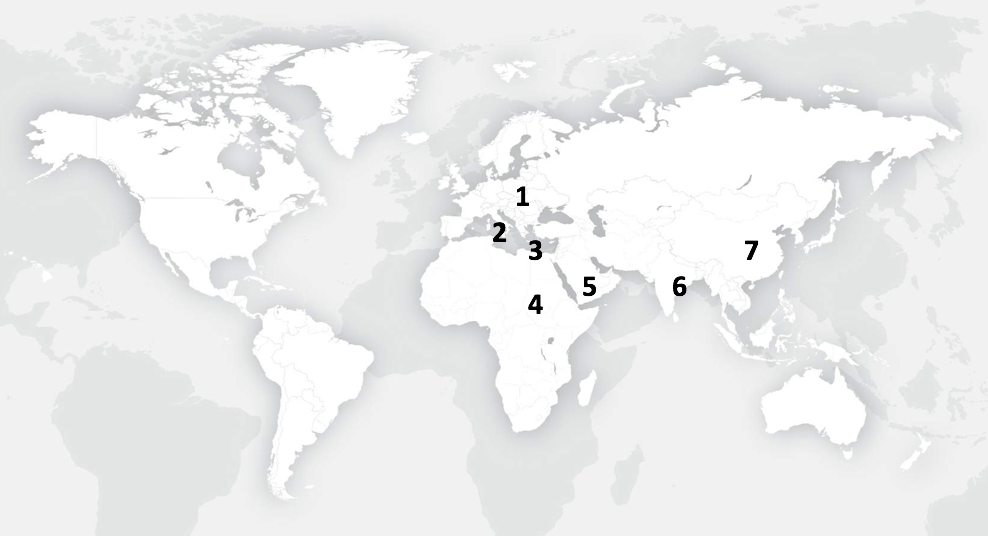
Essential oils have enhanced lives for thousands of years, offering a variety of benefits—from cosmetic, aromatic, and dietary purposes to spiritual and religious uses.
In fact, oils are mentioned in many historical texts from around the world. They are well documented for their uses and benefits in ancient times. For 25 years, Young Living has taken the lead in bringing this ancient tradition to modern times, introducing millions to life-changing nature-based wellness.
1. EUROPEAN GOLDEN AGES
During the Crusades, the Knights and their armies discovered essential oils and the distillation methods used to extract them in the Middle East. They also become acquainted with some of the books written by Avicenna the Arab about oils.
These knights then spread that knowledge throughout Western Europe. Essential oils such as Lavender, Rose, Frankincense, Pine, Rosemary, Spearmint, Marjoram, Oregano, Sage were commonly used for:
-perfume
-cooking
-medicinal purposes
-spiritual ceremonies
2. ANCIENT ROME
The most prominent borrower of Egyptian knowledge was the Roman Empire. Rome invaded and conquered Egypt in 30 B.C., wresting control from Cleopatra and establishing itself as the preeminent civilization in the region. Romans used Balsam, Frankincense, Cedarwood, Bay Laurel, Pine, Fir, Juniper and many more essential oils with decadence daily for:
-Bathhouses
-Massages
-Therapeutic practices
-Medicinal purposes
Oils were also used to scent the hair, body and the bed. The most exotic oils available were blended by highly skilled perfumers, creating celebrated fragrances.
3. ANCIENT GREECE
Between 400-500 B.C. the Greeks recorded knowledge of essential oils adopted from the Egyptians. The Greek physicians Galen and Hypocrites (460-377 B.C.), known to us as the “Father of Medicine” documented the effects of some 300 plants including thyme, saffron, marjoram, cumin, peppermint, myrrh, fennel, and many more. Ointment of Myrrh was carried by Soldiers into battle to counter infections and other essential oils were included in:
-mild physio-therapies
-massage with infusions
-baths
Medicine
-Holism or aromatherapy
4. ANCIENT EGYPT
Egyptians used aromatic oils as early as 4500 B.C. They were by all accounts the first to develop the art of extracting essential oils such as Myrrh, Frankincense, Lotus and Cinnamon, Rose, almond and other for:
-Cosmetics
-Perfumes
-Spiritual and Religious ceremonies especially mummification
-therapeutic treatments
One of the first recognized compilations by ancient healers is called the Evers Papyrus. Although it dates from approximately 1,500 B.C., it is believed to have been copied from earlier texts. The scroll contains recipes, ceremonies, and other information that Egyptians deemed worthy of preservation.
5. MIDDLE EASTERN GOLDEN AGE
The largest trade commodity in Arabia at the time was Frankincense, which not only brought honor to the place but also a great prosperity. Ali-Ibn Sana a.k.a. Avicenna the Arab who lived from 980-1037 A.D. wrote books on the properties of 800 plants and their effects on the human body. He was also credited for discovering and recording the method of distilling essential oil as we know it today.
Frankincese, myrrh, Jamsone, Rose, Amber, Comomile, Cinnamon, Cardamom and many more were used for:
-perfume
-Medicinal purposes
-Aromatherapy
-Spiritual and Religious ceremonies
-cooking
6. ANCIENT INDIA
Traditional Indian medicine called “Ayur Veda” has a 3000-year history of incorporating essential oils into their healing potions. Vedic literature lists over 700 substances including cinnamon, ginger, myrrh, sandalwood, Jasmine, rose, lotus, cannabis, and other essential oils as effective for:
-Medicinal purposes
-religious ceremonies
-Spiritual uplift and cleansing of the soul
-Cosmetics
-Bathing
-Massage
-Aromatherapy-body and mind relaxation
7. ANCIENT CHINA
The use of aromatic oils was first recorded in China between 2697-2597 B.C. during the reign of Huang Ti, the legendary Yellow Emperor. His famous book “The Yellow Emperor’s Book of Internal Medicine” contains uses for several aromatics and is still considered a useful classic by practitioners of eastern medicine today.
In Ancient China essential oils such as Frankincense, Myrrh, galbanum, cinnamon, cedarwood, juniper, and spikenard were abundantly used in Traditional Chinese Medicine for:
-Healing and relaxation i.e. cupping and acupuncture.
-Help with non-healing wounds
-Improved sense of internal beauty and esteem
-Enhanced nobility
-Solitary, distraction-free state and milder temperament
